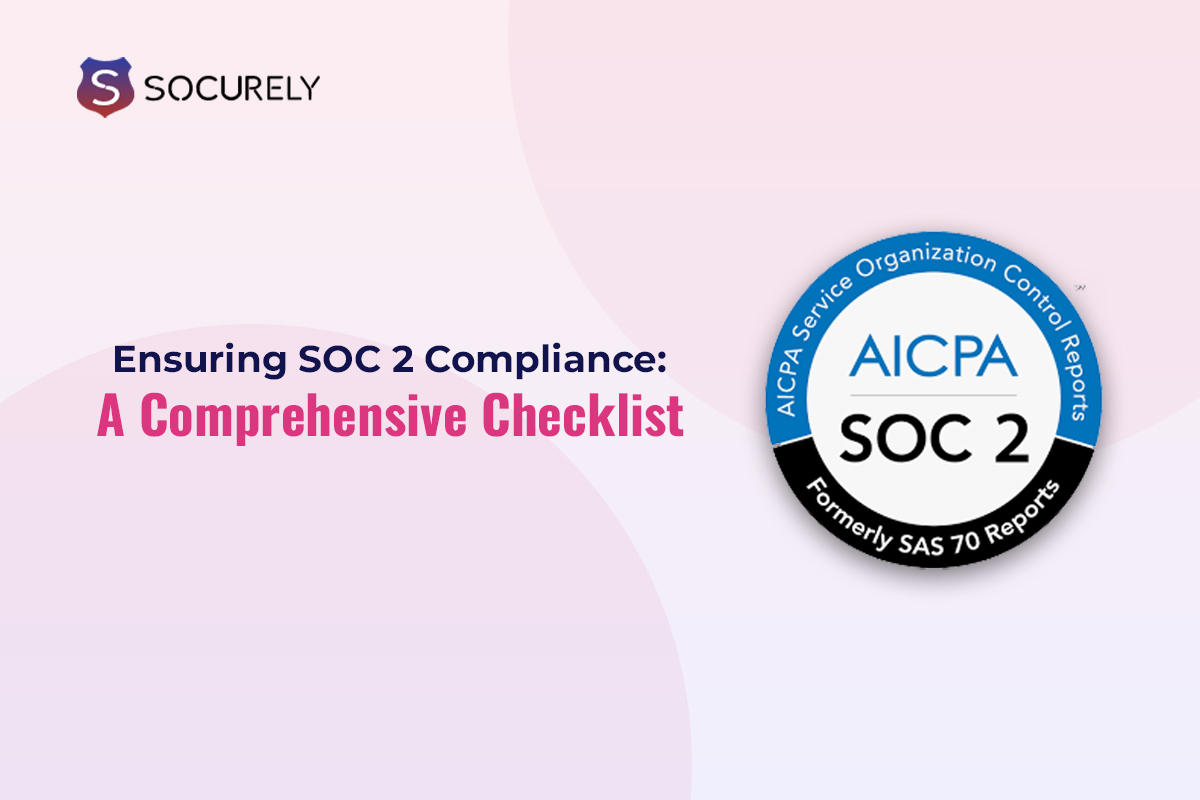In today’s increasingly digital landscape, data security, and privacy have become paramount concerns for businesses and their customers alike. Achieving SOC 2 (Service Organization Control 2) compliance is one-way organizations can demonstrate their commitment to safeguarding sensitive data.
SOC 2 compliance is not just a certification; it’s a validation of a company’s commitment to data security, availability, processing integrity, confidentiality, and privacy.
In this comprehensive checklist, we’ll take a close look at the key aspects of ensuring SOC 2 compliance and the criteria that must be met.
Understanding SOC 2 Compliance
SOC 2 is a framework designed by the American Institute of CPAs (AICPA) to evaluate the controls that a service organization has in place to protect customer data and ensure the security of its systems. Unlike SOC 1, which focuses on financial controls, SOC 2 focuses on the security, availability, processing integrity, confidentiality, and privacy of customer data.
This framework is particularly relevant for businesses that provide services involving the storage or processing of customer data, such as cloud service providers, data centers, and SaaS companies.
The SOC 2 Trust Services Criteria
SOC 2 compliance is based on five trust services criteria (TSC), each of which addresses specific aspects of data security and privacy. Let’s break down these criteria and the checklist for each one:
Security
The security criterion assesses whether a service organization’s systems are protected against unauthorized access, both physical and logical. Here’s a checklist to ensure compliance:
- Access Controls: Implement access controls to restrict unauthorized users. Use strong authentication methods and authorization processes.
- Vulnerability Assessments: Conduct regular vulnerability assessments and penetration testing to identify and address security weaknesses.
- Monitoring and Logging: Monitor and log system activity, including access and changes, to detect and respond to security incidents.
- Incident Response Plan: Establish an incident response plan for handling security breaches, including notification and recovery procedures.
- Physical Security: Secure physical access to data centers and critical infrastructure to prevent unauthorized entry.
Availability
Availability focuses on ensuring that a service organization’s systems are accessible and operational when needed. To meet this criterion, consider the following checklist:
- Redundancy and Failover: Implement redundancy and failover mechanisms for critical systems to minimize downtime in case of failures.
- Monitoring and Uptime: Monitor system uptime and response times to proactively address issues and ensure availability.
- Backup and Recovery: Perform regular backups of data and systems and conduct data recovery tests to ensure data can be restored.
- Disaster Recovery Plan: Have a disaster recovery plan in place to guide actions during major disruptions.
- Capacity Planning: Conduct capacity planning to ensure that systems can handle increased demand without degradation of service.
Processing Integrity
Processing integrity ensures that data is processed accurately, and systems perform their intended functions without errors or omissions. Here’s a checklist for compliance:
- Data Validation Checks: Implement data validation checks at various stages of data processing to ensure accuracy and completeness.
- Documentation: Document data processing procedures and workflows to maintain transparency and consistency.
- Data Quality Assessments: Conduct regular data quality assessments to identify and rectify errors or inconsistencies.
- Error Monitoring: Monitor for errors and discrepancies in data processing and address them promptly.
- Change Management: Establish change management controls for system updates and modifications to prevent unintended consequences.
Confidentiality
Confidentiality focuses on protecting sensitive data from unauthorized access or disclosure. To meet this criterion, use this checklist:
- Data Encryption: Encrypt sensitive data both in transit and at rest to prevent unauthorized access in case of data breaches.
- Access Reviews: Conduct regular access reviews and audits to identify and revoke unnecessary privileges.
- Employee Training: Train employees on data handling and confidentiality to promote awareness and compliance.
- Data Classification: Have data classification policies in place to categorize data based on sensitivity and protection requirements.
Privacy
Privacy assesses whether personal information is collected, used, retained, and disclosed in accordance with an organization’s privacy notice and applicable regulations. To ensure compliance, consider this checklist:
- Privacy Policy: Develop and maintain a comprehensive privacy policy that outlines how personal information is handled.
- Consent Mechanisms: Obtain informed consent from individuals for collecting and processing their personal data.
- Data Access: Provide individuals with access to their own data and allow them to request corrections or deletions.
- Privacy Impact Assessments: Conduct privacy impact assessments (PIAs) for new projects or changes to assess privacy risks.
- Data Protection Officer (DPO): Appoint a Data Protection Officer (DPO) if required by privacy regulations to oversee compliance.
Additional Considerations
In addition to the trust services criteria, several other factors should be considered when ensuring SOC 2 compliance:
- Define the Scope of the Audit: Clearly identify the systems, processes, and data that fall within the scope of the SOC 2 audit.
- Engage a Qualified Auditor: Select a certified SOC 2 auditor who understands the specific requirements of your industry.
- Document Policies and Procedures: Maintain comprehensive documentation of your organization’s controls and processes.
- Readiness Assessment: Evaluate your organization’s current state of compliance to identify any gaps.
- Remediate Deficiencies: Address any issues or weaknesses identified during the audit process.
- Regular Testing: Continuously assess and test controls to ensure they remain effective.
- Communicate Findings: Share the SOC 2 report with relevant stakeholders, such as customers, to build trust and transparency.
- Maintain Ongoing Compliance: SOC 2 compliance is not a one-time effort. It requires continuous monitoring and improvement.
Conclusion
Achieving SOC 2 compliance is a significant milestone for service organizations, as it demonstrates a commitment to data security, availability, processing integrity, confidentiality, and privacy. By following this comprehensive checklist and aligning with the trust services criteria, businesses can not only meet regulatory requirements but also build trust with their customers and partners.
Remember that SOC 2 compliance is an ongoing process that requires vigilance and dedication. Regular assessments, testing, and continuous improvement are key to maintaining compliance and upholding the highest standards of data security and privacy.
Ultimately, SOC 2 compliance is not just a checkbox; it’s a testament to an organization’s commitment to safeguarding sensitive information in an increasingly interconnected world.







